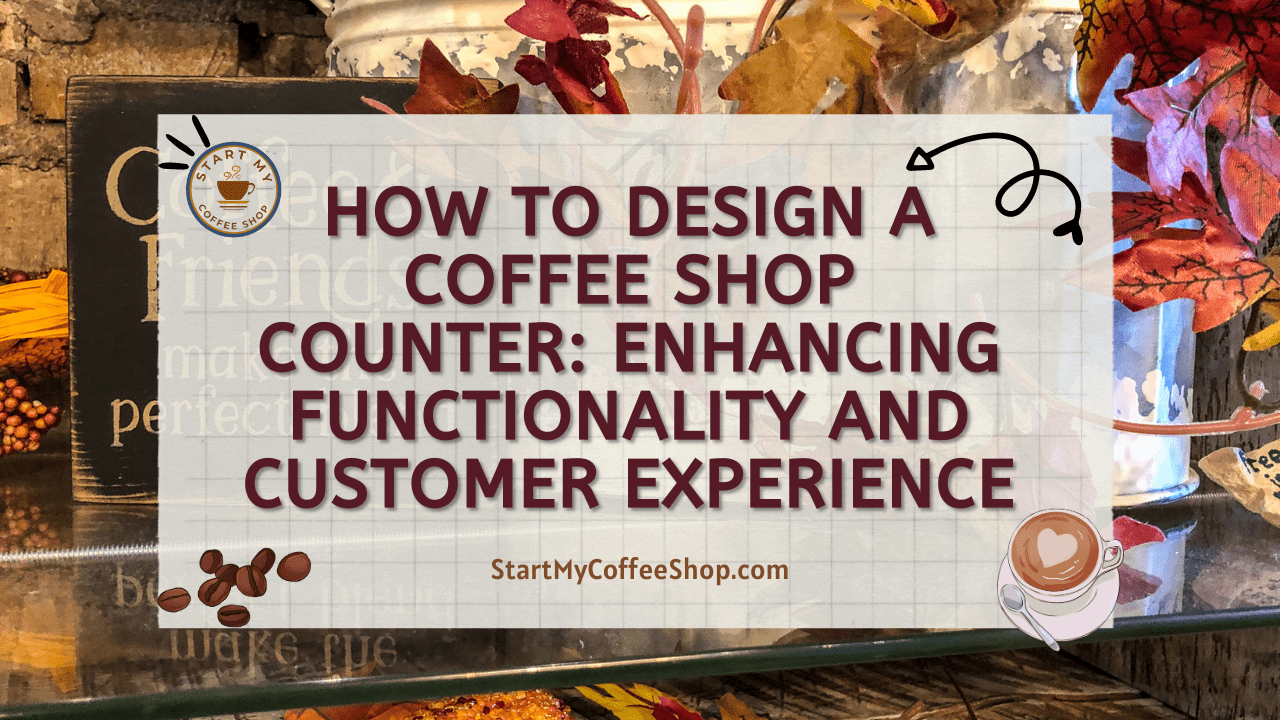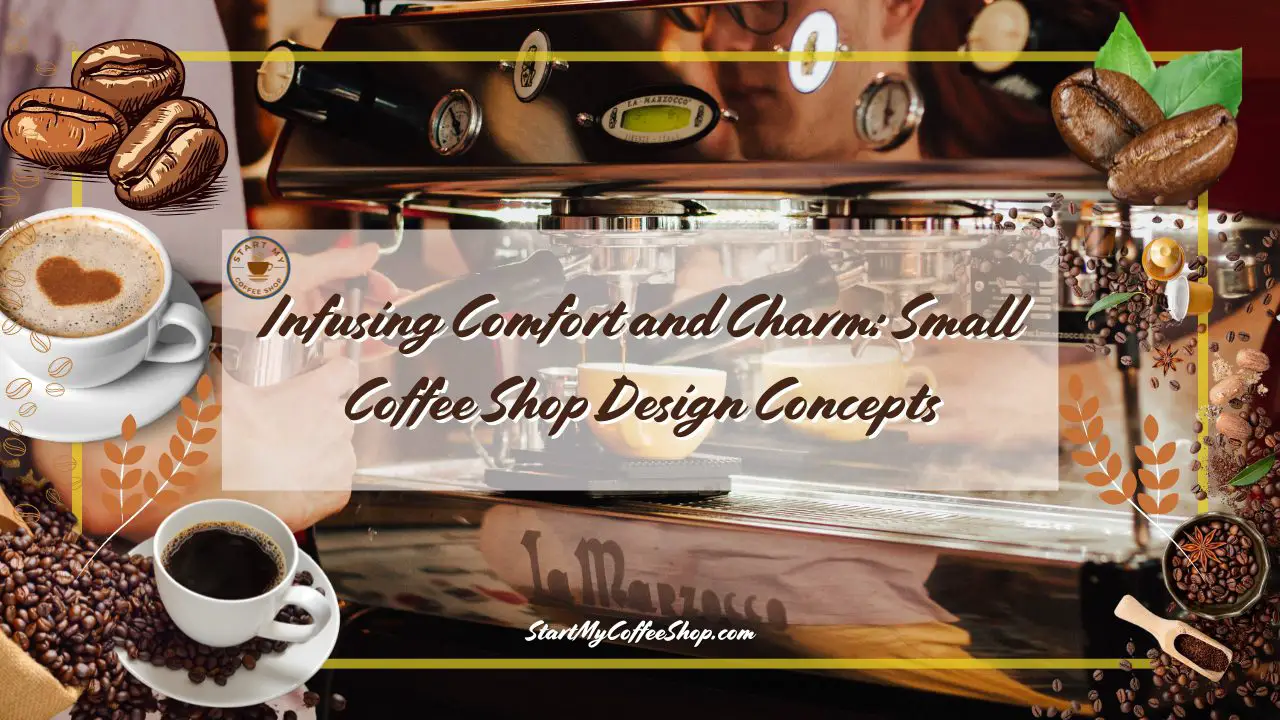Designing a coffee shop counter that maximizes functionality and elevates the overall customer experience is crucial for creating a thriving coffee shop business. The counter serves as the heart of the shop, where customers place their orders, interact with baristas, and savor their favorite beverages.
To design an effective coffee shop counter, prioritize functionality and customer experience. Consider layout, accessibility, and efficient workflow. Incorporate elements like ample workspace, accessible storage, clear signage, and strategic placement of equipment.
In this article, I will delve into the essential elements of designing an effective coffee shop counter that optimizes functionality and enhances the overall customer experience.
Analyzing Space and Layout
 Designing an efficient coffee shop counter requires a thorough analysis of the available space and careful consideration of the layout. Start by examining the dimensions and shape of the area designated for the counter.
Designing an efficient coffee shop counter requires a thorough analysis of the available space and careful consideration of the layout. Start by examining the dimensions and shape of the area designated for the counter.
Take note of any architectural features, such as pillars or windows, that may impact the layout. This analysis will help you make the most of the available space and ensure a well-organized counter.
Consider the flow of customer traffic within the coffee shop. Observe how customers enter and move through the space. Are there any natural pathways or bottlenecks to be aware of? By understanding customer behavior, you can plan the counter layout to facilitate a smooth flow of traffic.
Take into account the placement of other furniture and equipment in the coffee shop. For example, if there are seating areas nearby, ensure they are strategically positioned to create a comfortable and inviting atmosphere. Pay attention to the proximity of electrical outlets and plumbing connections for the coffee machines and other equipment.
To optimize functionality, the coffee shop counter should be easily accessible from multiple entry points. This ensures that customers can approach the counter from different directions, reducing congestion and wait times. Consider the location of entrances and exits and position the counter accordingly.
Creating designated areas for order placement, pick-up, and condiments is another effective strategy. Mark these zones to guide customers and staff. This segregation helps streamline operations by separating the stages of the customer journey and preventing confusion. It also allows baristas to work efficiently and prevents bottlenecks caused by overlapping activities.
Prioritizing Workflow and Efficiency
 An efficiently designed coffee shop counter focuses on optimizing workflow for both customers and baristas. The placement of equipment, such as espresso machines, grinders, and blenders, plays a significant role in creating a logical and ergonomic setup.
An efficiently designed coffee shop counter focuses on optimizing workflow for both customers and baristas. The placement of equipment, such as espresso machines, grinders, and blenders, plays a significant role in creating a logical and ergonomic setup.
Baristas should be able to access these tools effortlessly, minimizing unnecessary movement and maximizing their productivity. Consider the workflow from the perspective of the barista, arranging the equipment in a way that allows for a smooth and efficient preparation process.
In addition to barista workflow, it is essential to organize the counter to facilitate a clear and intuitive ordering process for customers. Clear and visible displays of the menu, prices, and promotions can help customers make informed choices quickly. Use attractive and easily readable signage to ensure that customers can navigate the options effortlessly.
Implementing a user-friendly point-of-sale (POS) system is vital for enhancing efficiency and reducing waiting time. Choose a system that is intuitive and easy to use for both staff and customers.
The POS system should seamlessly handle transactions, allowing for swift order processing and payment. Integration with inventory management systems can also help keep track of stock levels and prevent delays caused by running out of ingredients.
By carefully considering the placement of equipment, creating a clear and intuitive ordering process, and implementing a user-friendly POS system, you can optimize workflow and enhance efficiency at your coffee shop counter. This ensures a smooth and enjoyable experience for both customers and baristas, ultimately contributing to the overall performance of your coffee shop.
Creating a Welcoming and Engaging Atmosphere
 The coffee shop counter serves as more than just a functional space; it presents an opportunity to create a welcoming and engaging atmosphere that leaves a lasting impression on customers. When designing the counter, consider the aesthetic elements that align with your coffee shop’s branding and ambiance.
The coffee shop counter serves as more than just a functional space; it presents an opportunity to create a welcoming and engaging atmosphere that leaves a lasting impression on customers. When designing the counter, consider the aesthetic elements that align with your coffee shop’s branding and ambiance.
Start by paying attention to the lighting. Warm and soft lighting can create a cozy and inviting environment. Avoid harsh fluorescent lights and opt for warm-toned bulbs that emit a comforting glow. Well-placed lighting fixtures can highlight the counter area, drawing customers’ attention and creating a focal point.
The color scheme is another crucial aspect to consider. Incorporate your coffee shop’s brand colors into the counter design. This consistent branding reinforces your shop’s identity and helps customers recognize and connect with your brand. Consider using these colors on the counter itself, through elements such as the countertop material, signage, or accents.
To add personality and charm, incorporate decorative elements. Fresh flowers in vases, artwork on the counter walls, or a chalkboard showcasing daily specials can create visual interest and contribute to a positive customer experience.
Fresh flowers bring a touch of nature and vibrancy, while artwork can reflect the coffee shop’s style and create conversation starters. The chalkboard is not only practical for displaying specials but also adds a touch of nostalgia and artisanal appeal.
Read more about Cost to Start Drive-Thru Coffee Shop: A Cupful of Expenses
Storage and Organization
Incorporating ample storage and organization solutions is a vital aspect of a well-designed coffee shop counter. Baristas need easy access to ingredients, utensils, and supplies to serve customers efficiently and maintain a smooth workflow.
To optimize storage, consider incorporating cabinets, shelves, and drawers strategically throughout the counter area. Cabinets can provide concealed storage for larger items, such as bulk coffee beans or extra supplies. Shelves can be used to display frequently used items, making them easily accessible for both baristas and customers. By keeping commonly used items within reach, baristas can work more efficiently and minimize time spent searching for supplies.
In addition to general storage, it is beneficial to create a dedicated space for barista tools. Tools like tampers, thermometers, and scales should have a designated area where they can be stored and accessed quickly.
Consider integrating hooks, compartments, or magnetic strips to keep these tools organized and readily available. This ensures that baristas can focus on their tasks without disrupting the flow of the counter or needing to search for specific tools.
When designing storage solutions, prioritize functionality and organization. Group similar items together and use labels or clear containers to enhance visibility and accessibility. This allows baristas to locate items with ease, reducing the chances of errors or delays during busy periods.
Consider the workflow and placement of storage areas for the tasks performed at the counter. For example, locate coffee bean storage near the grinder for quick refills, and place syrups and condiments near the order placement area. By strategically positioning storage areas, you can minimize the movement required and optimize efficiency during the preparation and serving processes.
Regularly evaluate your storage needs and adjust accordingly. As your coffee shop grows and evolves, you may need to adapt the storage solutions to accommodate changing inventory or equipment requirements. Continuously seek feedback from your baristas to identify any pain points or areas where storage and organization can be improved.
By incorporating ample storage and organizing solutions, including cabinets, shelves, and drawers, and creating dedicated spaces for barista tools, you can ensure that your coffee shop counter is equipped to handle the demands of daily operations. Efficient storage and organization not only contribute to a streamlined workflow but also enhance the overall efficiency and professionalism of your coffee shop.
Considering Accessibility and Inclusivity
Inclusive design is an essential aspect of creating a coffee shop counter that caters to the needs of all customers, regardless of their physical abilities. One crucial consideration is ensuring that the counter height accommodates individuals who use wheelchairs or have limited mobility.
By setting the counter at an appropriate height, you allow customers in wheelchairs to comfortably reach the counter and engage in conversations with baristas. This simple adjustment promotes inclusivity and ensures that everyone can access the services offered at the counter.
Additionally, providing clear signage and menus that are easy to read is essential for customers with visual impairments. Use high-contrast colors and legible fonts to enhance visibility. Braille signage can be incorporated to provide information for those who are blind or have low vision. Including large-print menus or providing digital menus that allow customers to adjust the text size can also be beneficial.
By making information readily accessible and easy to comprehend, you create a more inclusive environment for customers with visual impairments.
Consider implementing assistive devices to further enhance accessibility at the coffee shop counter. Hearing loops, for example, can be installed to assist customers with hearing impairments.
These loops use electromagnetic technology to transmit sound directly to hearing aids or cochlear implants, eliminating background noise and enhancing audio clarity. Tactile strips can also be used to guide customers with visual impairments, indicating different areas of the counter or providing directional cues.
Beyond physical adjustments, training staff to be sensitive to the needs of customers with disabilities is crucial. Educate your team on inclusive practices, such as offering assistance, being patient, and communicating effectively. Staff members should be prepared to provide information or help customers navigate the counter area if needed.
By prioritizing inclusivity, you create a welcoming environment where all customers feel valued and comfortable. Implementing accessible design features such as appropriate counter height, clear signage, and easy-to-read menus ensures that customers with diverse abilities can fully enjoy their coffee shop experience.
Going the extra mile by incorporating assistive devices and providing staff training on inclusivity helps foster a sense of belonging and demonstrates your commitment to creating an inclusive space for everyone.
Summary
Designing an effective coffee shop counter requires careful consideration of functionality and the overall customer experience. By analyzing the space and layout, prioritizing workflow and efficiency, creating a welcoming atmosphere, providing ample storage and organization, and considering accessibility and inclusivity, coffee shop owners can design a counter that optimizes functionality and enhances the overall customer experience.
The counter is not only a place for transactions but also a space where customers engage with your brand. By investing time and effort into thoughtful design, you can create a coffee shop counter that becomes a focal point of positive customer interactions, fostering loyalty and progress in your coffee shop business.
Frequently Asked Questions
1. How can I determine the best layout for my coffee shop counter?
Consider the flow of customer traffic, the placement of equipment, and the accessibility of different areas.
2. What equipment should I prioritize when designing the coffee shop counter?
Focus on essential equipment like espresso machines, grinders, blenders, and a user-friendly point-of-sale system.
3. How can I create a welcoming atmosphere at the coffee shop counter?
Pay attention to lighting, color schemes, and signage that align with your brand and create a cozy ambiance. Add decorative elements, such as fresh flowers or artwork, to enhance the visual appeal and engage customers.
To learn more on how to start your own coffee shop checkout my startup documents here
Please note: This blog post is for educational purposes only and does not constitute legal advice. Please consult a legal expert to address your specific needs.

Hi! I’m Shawn Chun
My adventure in coffee began when I first launched my first coffee shop back in the early 2000s. I had to figure out so many things on my own and to make it worse within 2 years of opening two large corporate coffee chains moved in just blocks away from me!
As I saw smaller and even some larger coffee shops in the neighborhood slowly lose customers to these giant coffee chains and slowly close up shop, I knew that I had to start getting creative…or go out of business.
I (like you may be) knew the coffee industry well. I could make the best latte art around and the foam on my caps was the fluffiest you have ever seen. I even had the best state-of-the-art 2 group digital Nuova Simonelli machine money could buy. But I knew that these things alone would not be enough to lure customers away from the name brand established coffee shops.
Eventually, through lots of trial and error as well as perseverance and creativity I did find a way to not only survive but also thrive in the coffee/espresso industry even while those corporate coffee chains stayed put. During those years I learned to adapt and always faced new challenges. It was not always easy, however, in the end, I was the sole survivor independent coffee shop within a 10-mile radius of my location. Just two corporate coffee chains and I were left after that year. All told the corporate coffee chains took down over 15 small independent coffee shops and kiosks and I was the last one standing and thriving.
Along the years I meet others with the same passion for coffee and I quickly learned that it is not only “how good a barista is” that makes a coffee shop successful, but the business side of coffee as well.
Hence why I started this website you are on now. To provide the tools and resources for up and coming coffee shop owners to gain that vital insight and knowledge on how to start a coffee shop successfully.
Stick around, browse through my helpful blog and resources and enjoy your stay! With lots of LATTE LOVE!
Shawn






